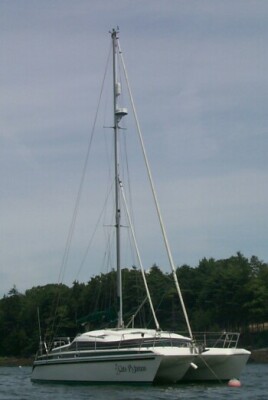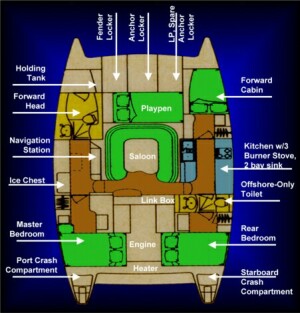 Our Prout Escale Compartment Layout Click on the image to enlarge it. Problem Areas and the hours required to fix them. Click on any link for further detail!
| The Cat's Pyjamas?Welcome to the boat repair section of my Web-site. As you are about to discover, we may have spent more time fixing the family Prout Escale Catamaran than sailing it. We chose to upgrade to a 39' Escale when we outgrew our 37' Snowgoose, the "von Quack". While that Prout catamaran also had a number of maddening defects, most of them were manageable and we thought we'd address the problem areas given our previous experience with the builder. Basically, we limited what Prout could install and paid a hefty premium for upgraded hardware on deck. After all, there are compelling reasons to own a Prout Catamaran. Their older designs arguably offer the best layout for cruisers. Today, the "classic" layout might look a bit dated but its true demise can be traced to the rise of the charter market. Nowadays, most catamarans are destined for charter and "modern" layouts reflect the importance of cramming as many people into the boat as possible. Thus, instead of having huge, functional galley and navigation areas, "modern" Catamarans squeeze both functions into much smaller spaces. But who asked the cook and navigator, they are paid employees, right? So if you are out to buy a boat, do not let this site dissuade your purchase decision if that boat is a Prout Catamaran. Rather, use the site as a check list for potential trouble spots. After all, Prouts have fantastic potential as voyagers and conscientious owners will have addressed the trouble spots already! We chose a owner layout that allowed enough room for four double bunks and two bathrooms. All cabins are much bigger than on the Snowgoose, sporting higher ceilings and wider hulls. The more modern design gives the Escale a feeling of much more space than the double-ended canoe design of the Snowgoose even though the hull is only two feet longer. Click on the image below to enlarge it. Our family contemplated selling the Cats PJs after we found the some of the worst defects. But the selling price would have reflected the condition of the boat. Thus, we decided to keep her and fix the defects as we found them. Much of the work in the earlier years ('95-'98) was not cataloged. Unfortunately, small projects snowballed into much bigger jobs as the extent of problems became clear. For example, our electrical issues started innocently enough with some water pump problems... three years later, almost the entire electrical system has been replaced as we discovered and fixed the inadequacies of the Prout Catamarans construction job. And there's the rub: While the traditional designs of Prout Catamarans reflect good thinking, experience, etc. our boat was apparently put together in the worst possible manner. Prout rushed to get the boat to the Miami boat show, going as far as shipping 8 employees to the United States to finish her before the show. Perhaps this is why our previous Prout didn't have as many defects as this Escale. For example, we found badly rusted plain steel pins holding the standing rigging to our masthead that someone at Prout Catamarans had substituted for the stainless ones supplied by ZSpar. We also found a cockpit drain that drained onto the engine instead of overboard. The electrical system was not fused properly nor did it meet ABYC standards. Most terrifying of all was the initial flexing of our Prout Escale - joints between walls and bulkheads opened and closed, windows cracked, and hull connections busted as the two hulls went in their respective directions. Thus, as far as we could tell, Prout Catamarans used a trial-by-error approach to boat building. Judging from the letters I have received from fellow Prout owners, we weren't the only ones with workmanship issues. Perhaps this is why the French multihull builders were able to take the charter market by storm. And as the cruising market contracted, so did Prout. Their attempts at building charter boats (the 38' and 46') came too late: Charter fleets worldwide had already standardized around other manufacturers. In 1999, Prout Catamarans was bought by the Canadian-based Quest group. Allegedly, the new owners would inject cash and use Prout Catamarans as a builder of choice for their charter fleet. Prout Catamarans was placed into receivership for the first time in Sept. 2001, only 14 months after being acquired. Six months later, the new Quest subsidiary called Prout UK that had bought the leftover Prout Catmarans assets was shut down permanently. Out of curiosity, I ordered a credit check. On my first Prout bankruptcy page I analyze Prout Catmarans' slow descent into receivership. To keep track of more recent developments in all things Prout, I have created a second Prout bankruptcy page. For example, I try to list where the hull-molds have gone, as several companies continue to manufacturer these excellent designs. | ||||||||||||||||||||||||||||||
|---|---|---|---|---|---|---|---|---|---|---|---|---|---|---|---|---|---|---|---|---|---|---|---|---|---|---|---|---|---|---|---|
But for all the time we lost due to the ineptness of Prout Catamarans building our Escale, one of the joys of the boating industry is the great number of hardworking, talented, and knowledgeable people that have helped us. Without their help and advice, we would have just given up. In particular, I would like to thank:
- My wife, who even as a fiancee had to endure many hours of work as part of the Cats PJs press gang and even more hours as a "Cat's PJs widow".
- The many friends who have lent helping hands on various projects. You know who you are.
- The people at ZSparsUK for their counsel regarding our rigging.
- The Perkins engineering department for their engine advice.
- Sure Marine for their excellent Webasto installation manual and technical support.
- Nigel Calder for writing his (now well-worn) boat maintenance manual. This is the best all-around manual on boat maintenance, bar none.
- S&L Engineering (now part of Lewmar) for their help on rehabilitating our Seawolf windlass.
- Ample Power for their great alternator, regulator, and web-site. Keeping the batteries charged is now easier than ever.
- Volvo, for identifying replacement parts, manuals, etc. to repair our saildrives.
- Emil Meyer and his engineering company in Germany for calculating the dimensions for our hydraulic couplings. His spline size and shape calculation tool is fantastic and the output is very clear. Further thanks to Rawling Gear in Massachusetts for delivering perfectly DIN-specification couplings.
- Further thanks to my colleagues at Arthur D. Little, Inc. as well as David Bourgeois for their engineering advice regarding the hydraulic propulsion system.
- Rexroth USA for chasing down obscure reference manuals and for telling me how to adjust the hydraulic pumps to suit our needs.
- Coastal and Hamilton Marine for their excellent catalogues and good prices.
- The American Boat and Yacht Council (ABYC) for trying to inject minimal standards into the marine industry.
- The Seven Seas Cruising Association and Info-Skipper for publishing real-life experiences with Marine equipment.


